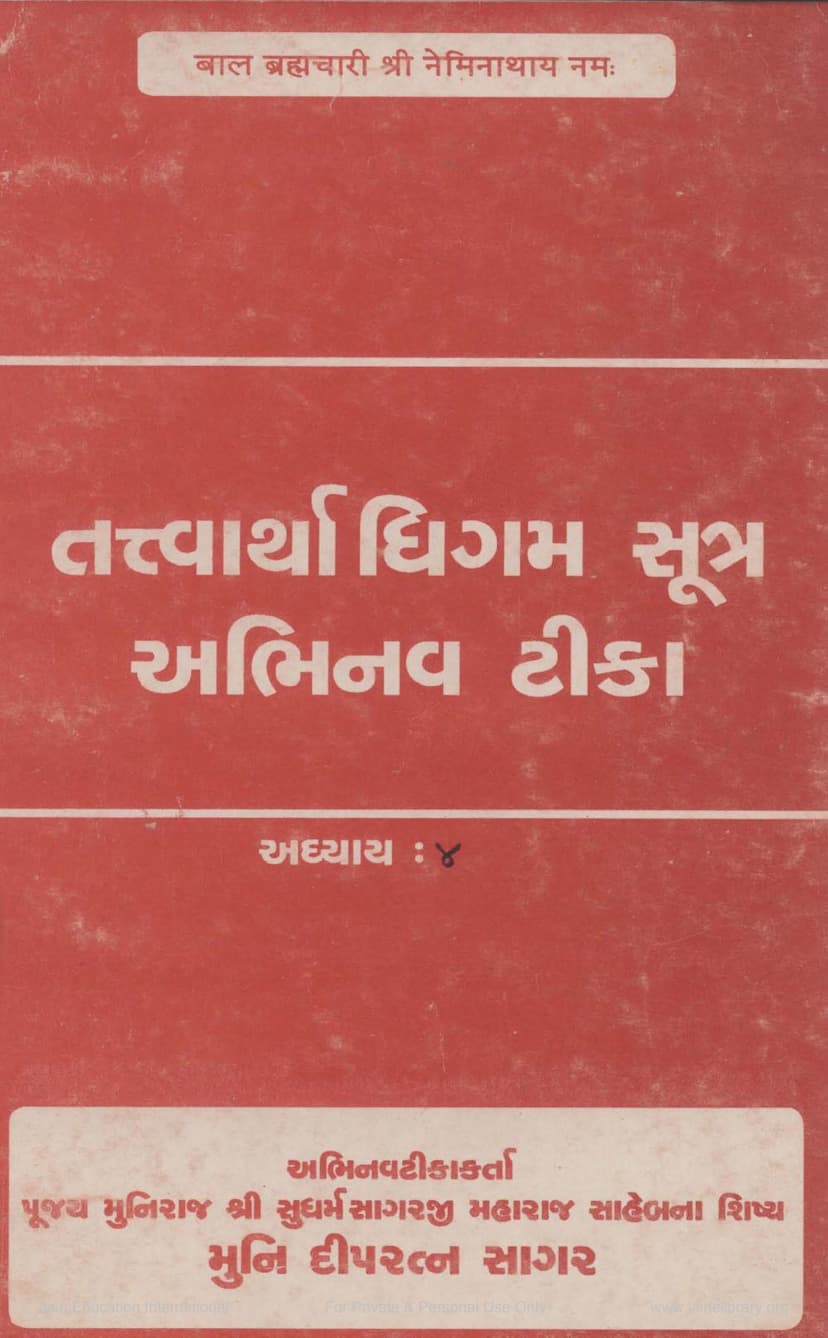Tattvarthadhigam Sutra Abhinav Tika Adhyaya 04
Added to library: September 2, 2025

Summary
This document is a detailed commentary, titled "Abhinav Tika" by Muni Deepratna Sagar, on the fourth chapter (Adhyaya 4) of the Tattvarthadhigam Sutra, a foundational text in Jainism. The commentary is published by Shrutnidhi, Ahmedabad.
The provided text is the initial part of this commentary, covering the introductory pages and the beginning of Chapter 4. Here's a comprehensive summary of the content presented:
Overall Purpose and Context:
- Textual Basis: The work is a commentary on the Tattvarthadhigam Sutra, specifically Chapter 4.
- Author/Commentator: Muni Deepratna Sagar, a disciple of Pujya Muniraj Shri Sudharmasagarji Maharaj Saheb, is the author of this "Abhinav Tika" (new commentary).
- Publisher: Shrutnidhi, Ahmedabad.
- Date: The commentary was initiated on Monday, Vaishakh Sud-5, 2050 (Vikram Samvat), corresponding to May 16, 1994.
- Focus: Chapter 4 primarily deals with the celestial beings (Devas) and the concept of their lifespan (Ayushya). It marks the conclusion of the study of the first fundamental truth (Tattva), which is the Soul (Jiva), by completing the discussion on the Devagati (celestial realm) as a part of the four states of existence.
- Underlying Goal: The author emphasizes that the extensive descriptions of the celestial beings are not the primary objective. Instead, they serve as a means to illustrate that attachment to any state of existence, including the celestial ones, can lead to entanglement. The ultimate goal is liberation (Moksha), and all this information is a tool to guide the aspirant towards that path.
Key Sections and Content Covered:
-
Title Page and Salutations (Pages 1-3):
- Devotional salutations to Bal Brahmachari Shri Neminath and Sri Anand-Kshama-Lalit-Sushil-Sudharmasagar Guru.
- Information about the author (Muni Deepratna Sagar), the inspirer (Pujya Muniraj Shri Sudharmasagarji M. Sa.), and the publisher (Abhinav Shrut Prakashan).
- Subject Index (Vishay Anukram): This is a crucial part, outlining the topics covered in the chapter and their corresponding page numbers. It provides a roadmap of the chapter's content. Key topics include:
- Types of Devas (Devonā Prakār)
- Leshya (aura/coloring) of Devas (Devonī Leshyā)
- Categories of Devas (Devonā Bhed)
- Number of Indras (Indronī Sankhyā)
- The life (duration) of various classes of beings (Bhavanvāsi, Vyantar, Jyotishk, Vaimanik, Naraka).
- The nature of their happiness (Devonū Kām Sukha).
- Details about different types of celestial beings: Bhavanvāsi (inhabitants of lower celestial mansions), Vyantar (intermediate celestial beings), Jyotishk (luminous beings), and Vaimanik (celestial beings residing in flying vehicles/mansions).
- The concept of "Kalpa" (abodes or realms).
- The placement of Lokantik Devas and Anur Devas.
- The calculation of lifespan (Bhavganna) for Tiryanch (transient beings).
-
Explanation of Key Terms (Page 4):
- Tattva: The true nature of things as they are (e.g., Jiva is Jiva, Ajiva is Ajiva).
- Artha: That which is known or understood.
- Tattvartha: The decision or understanding of Tattvas.
- Adhigama: Knowledge or special knowledge.
- Sutra: A concise statement conveying profound and extensive meaning.
- The Tattvarthadhigam Sutra is named so because it systematically elaborates on the seven Tattvas (Jiva, Ajiva, Ashrav, Bandh, Samvar, Nirjara, Moksha) in sutra form.
-
Introduction to Chapter 4 (Page 5):
- Chapter 4 contains 53 sutras.
- It covers the topic of the four types of celestial beings (Chaturvidha Devagati) and also concludes the discussion on the Soul (Jivatattva).
- Chapter 1 covered Right Faith and Right Knowledge. Chapter 2 began the discussion on the Soul. Chapter 3 discussed beings in the Narak, Manushya, and Tiryanch realms. Chapter 4 provides information about the Devagati.
- Although the chapter primarily deals with the Upper World (Urdhvalok), the presence of Devas in all three worlds means the chapter touches upon all three realms.
- The author reiterates that the description of Devas is a part of the four states of existence, and the main aim is not just to inform about Devas but to guide the soul away from attachment to these realms and towards the goal of Moksha.
- The descriptions of Devas are compared to the detailed exposition of Narak (hellish beings) in Chapter 3.
-
Sutra 1: Classification of Devas (Page 6 onwards):
- Sutra: "Devāś Catur Nikāyāḥ" (Devas are of four Nikāyas/categories).
- Explanation: The four categories of Devas are:
- Bhavanapati: Inhabitants of lower celestial mansions.
- Vyanter: Intermediate celestial beings who move between realms.
- Jyotishk: Luminous celestial beings (Sun, Moon, stars).
- Vaimanik: Celestial beings residing in flying vehicles/mansions, residing in higher heavens.
- Etymology: The term "Deva" is derived from the root "div" with meanings related to play, victory, conduct, happiness, and brilliance. Devas are characterized by their ability to move at will, freedom from hunger and thirst, luminous bodies, and swift movement.
- Nikaya: Refers to a group, class, or species. These four categories are also explained as distinct dwelling places.
- Detailed Locations: The text provides specific details about the locations of these four types of Devas within the different realms of the universe (Adholok, Madhyalok, Urdhvalok).
- Beyond the Four Categories: The text also references "Bhāva Deva" (realized celestial beings) as described in the Bhagavati Sutra, which includes: Bhavyadravya Deva, Naradeva, Dharmadeva, Devādhideva, and Bhāva Deva. However, the chapter primarily focuses on the "Bhāva Deva" who are in the celestial state due to the rise of Devagati Nama Karma.
Overall Impression:
The initial pages provide a thorough introduction to Chapter 4, setting the context, defining key terms, and outlining the chapter's structure. The commentary emphasizes the ultimate goal of Jain philosophy, which is liberation, and how the descriptions of the celestial realms are to be understood as aids to detachment and spiritual progress, rather than objects of attachment themselves. The commentary appears to be meticulously detailed, referencing various sources and offering layered explanations of the concepts.